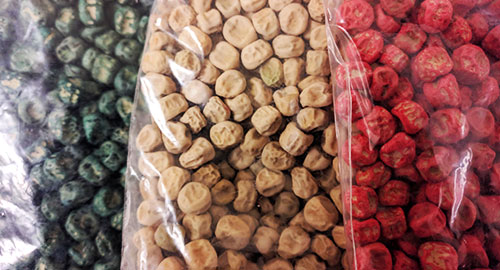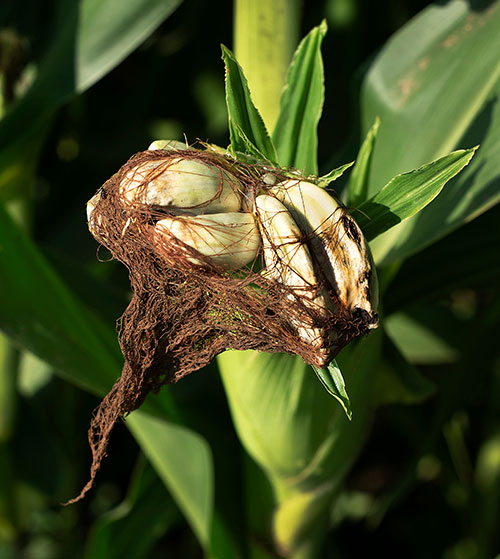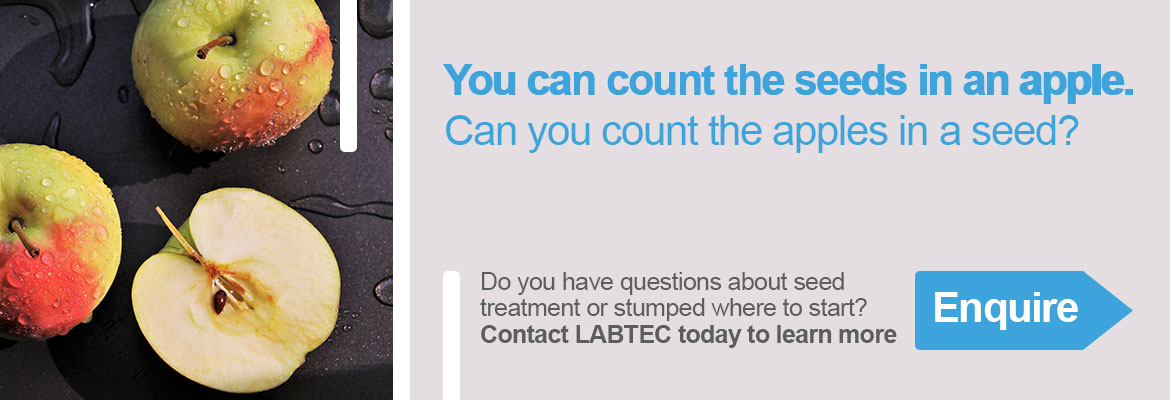Why so many colours? We’re not talking about a bag of jellybeans. Treated seeds come in many vibrant colours for the purpose of distinguishing that the seed has been treated. In some global jurisdictions, the colour is required under legislation to distinguish seeds treated with pesticides.
Some manufactures apply colour as a type of colour code of the type of treatment applied. Therefore, even if the seeds are no longer in their original packaging, a commercial farmer or avid residential gardener can easily identify the seed is treated for planting use only – not for consumption and to avoid potentially dangerous misuse.

Why are seeds coloured? Seed treatment is an important part of establishing a healthy plant.
The evolution of seed treatments
The practice of treating seeds to provide protection against pests, disease and decay has existed for centuries. Depending on the active ingredient, some of these more modern treatments deliver control once planted, while others offer protection in storage.
New Zealand’s pastoral landscape may appear no different to many pasturelands around the world, given the history of early colonisers’ attempting to replicate European farming methods. However, significant differences in ecosystems eventually exposed major implications in crop yields and the severity of pest impacts.
Seed treatment solutions require ongoing and evolving processes in the research and development (R&D) cycle. Scientists have made significant innovations to improve farming methods and protect our seed supply. Technological advances in pesticide formulations and application methods have also affected pesticide use in agriculture. Ultimately, developments in seed treatments aim to provide tailored products that are safe for seeds, humans and the environment.
Disease as an ongoing challenge
Seed rot, seedling blight and damping-off are diseases that lead to decay of germinating seeds and young seedlings, represent a challenge for plant breeders, Agrochemical companies, distributers and ultimately farmers. Infected seeds may rot and die prior to or shortly after germination, or plants may emerge and develop rotting roots and stems.
Head smut is an example of a disease of corn plants that can lead to yield losses. The infection is caused by the fungus Sporisorium reiliana. Prevalent all over the world, in New Zealand its of particular concern in Gisborne. Spores (teliospores) of S. reiliana, present in the soil or on contaminated seed, will infect the plant during seed germination and early seedling growth.
Some methods of control include crop rotation and managing nutrition levels. Hybrid plants with good resistance to head smut are available. The use of fungicidal seed treatments, such as Propioconazole, also provides an effective control measure.

Corn head smut fungus disease on ears of rotting corn in farm field.
Seed treatment products in New Zealand
Many seed treatments require the use of chemical compounds to control diseases and pests, such as the Argentine stem weevil (ASW, Listronous bonariensis) and African black beetle (Heteronychus arator) - both accidentally introduced insect pest species that are extremely costly for New Zealand.
Seed treatment solutions must undergo highly regulated trials before they are released to the market. In New Zealand, the manufacture, formulation, importation, sale, use of agricultural chemicals must be registered and follow the requirements outlined under the Agricultural Compounds and Veterinary Medicines Act 1997. Other applicable legislation includes the Biosecurity Act 1993 and the Hazardous Substances and New Organisms Act 1996. The New Zealand Grain & Seed Trade Association (NZGSTA) also provides guidelines for the industry.
Analysis of seed treatments
LABTEC is an independent research and testing laboratory that routinely performs HPLC analysis on a wide range of seed treatments, including chemical fungicides and insecticides listed below.
|
Examples of active ingredient(s)
|
Type
|
Brief description and notes
|
|
|
Phenolic compounds
|
|
- Imidacloprid
- Clothianidin
- Thiamethoxam
|
Neonicotinoids (neonics)
|
- Group of insecticides.
- Applied to the seed or roots (as a soil drench) or as foliar spraying.
|
- Carboxin
- Cymoxanil
- Fludioxonil
- Fluopyram
- Fluxapyroxad
- Metalaxyl-M
- Thiram
|
Fungicide
|
- Pesticides.
- Kill or prevent the growth of seed-borne and soil-borne fungi and their spores, which may interfere with seed germination or may infect the seedling soon after germination.
|
- Fluquinconazole
- Ipconazole
- Prothioconazole
- Tebuconazole
|
Triazole fungicide
|
- Group of fungicides.
- Used effectively to protect various crops against fungal diseases and for the treatment of fungal infections.
|
Whether you’re interested in testing the active loading of a seed treatment or a large range of other chemical analysis, LABTEC has the solutions designed to work for you.
For more information on the range of tests available, costs or turnaround times, contact us today!
